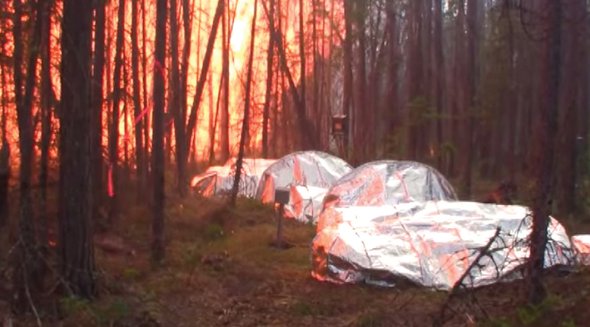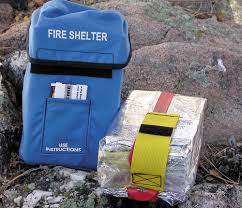What type of protective gear do firefighters wear?
Standard Personal Protective Equipment (PPE) includes the following:
- Nomex Shirt (almost always yellow)
- Nomex Pants (usually green, but sometimes khaki)
- 8” Leather Boots with a vibram sole
- Leather Gloves
- Helmet
- Safety glasses
- Ear Plugs
Notice anything missing? Some people are surprised to learn that wildland firefighters do not use respirators or SCBA (Self-Contained Breathing Apparatus) equipment like structural firefighters. Why is this? FIrst off, it’s not necessary. Structural firefighting requires firefighters to be active in enclosed environments, filled with noxious gases and searing temperatures. The superheated air within a burning building could seriously damage a firefighters lungs, and the gases are capable of killing a firefighter with just a few breaths. Thus, SCBA gear is necessary to operate in that environment. In wildland firefighting, it is a different story. Although it is worth mentioning that engine crews will carry SCBA gear on their engines. It is most commonly used when they’re called to deal with a burning vehicle.
So while the wildland firefighter is required to operate in smoke-filled environments, it is more of a nuisance than anything. That being said, there were quite a few times when I was either attacking a fire’s head during direct fireline construction, or holding a strip of line during a burnout operation, when I wished I had a respirator or something – anything – to provide some respite from the intense smoke. Keeping your cool in the smoke is one of the toughest things that a wildland firefighter must do. Your eyes will start stinging. Your nose will start running, your throat will dry and cause you to start coughing uncontrollably, and your mind will tell you to run and find clean air. But it is the ability to overcome that fear that separates wildland firefighters from everyone else. You might be questioning whether or not you could handle a situation like that right now. Don’t worry – you wouldn’t be the first. Truthfully, I had some doubts myself. Let me assure you – you will find a way. What kept me motivated was that I was not going to be the first guy to tap out. I was going to suck it up, and hang in there as long as the guy to my left and to my right were still cutting line When you make it not just about you, but about your commitment to the team, you’ll be amazed at how far you can push the bounds of your endurance.
So while respirators are not standard-issued gear, fire shelters are. All firefighters are required to carry a fire shelter when on an active fire.

Photo Courtesy of Scientific American and Ian Grob, U.S. Forest Service
So, what’s a fire shelter? At first glance, it looks like little more than a large silver space blanket. Or an enormous piece of tinfoil. Neatly folded into a package the size of a small shoebox, most people are underwhelmed when they first lay eyes on one. Many have compared it to an oversized hot dog wrapper. But the truth is that fire shelters save lives. Since becoming a requirement for all wildland firefighters responding to federal wildland fires, they have been credited with saving over 300 lives. In fact, this sentence was written less than a week after six Navajo Hotshots deployed their fire shelters on a fire on the Fort Apache Indian Reservation in Arizona. The firefighters were treated for smoke inhalation, but were otherwise uninjured. Six more lives that were saved because they carried these life saving devices.
How do they work? Very simply, they work by reflecting heat away from a firefighter. In an entrapment situation, a firefighter would find a space clear of flammable materials, pull out his fire shelter, wrap himself in it like a blanket, and lay down on the ground…and wait for the danger to pass. It is important to know that fire shelters don’t do a very good of reflecting direct flames. They’re intended to be deployed in a clearing, away as much as possible from contact with flames and ember wash. When used properly, they can be very effective. However, if a firefighter were to wrap himself in a fire shelter and attempt to walk through flames…he would quickly regret his decision. While not perfect, they’re nevertheless an invaluable piece of kit that saves lives.
